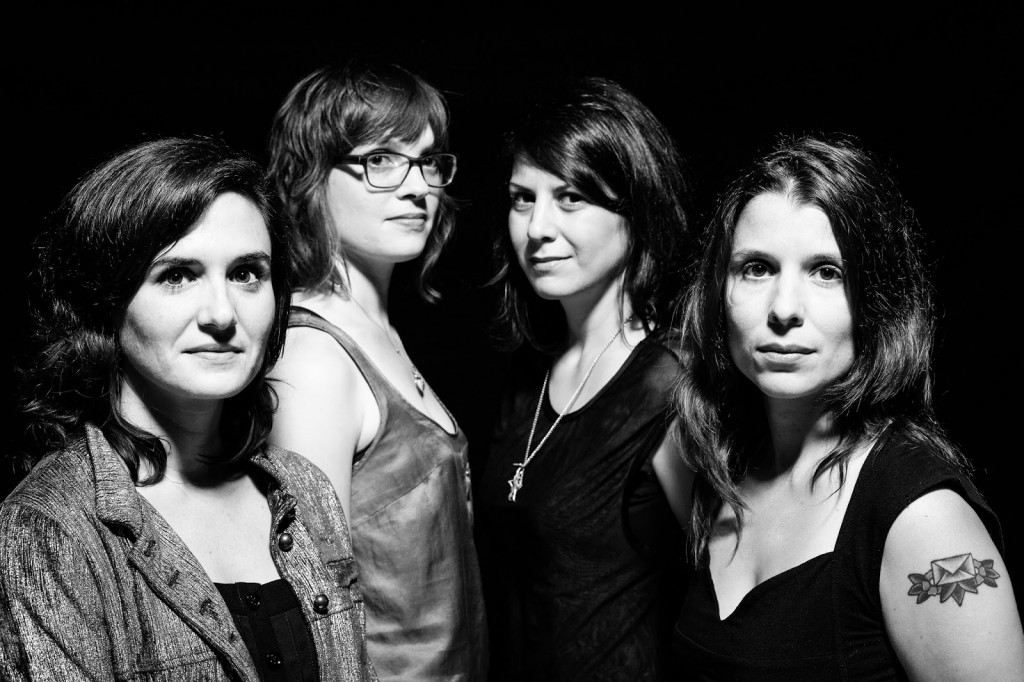Music at First opener gets to the “Heart” of the matter with premiere

Till by Turning performed Katherine Young’s “Four Chambered Heart” in its world premiere Friday night at First Presbyterian Church in Brooklyn.
The Music at First series, one of the finest classical music concert values in New York, opened their season with a rumble Friday night at the First Presbyterian Church of Brooklyn: the premiere of Katherine Young’s turbulent and compelling Four Chambered Heart.
Cast in eight parts, Young calls Four Chambered Heart “a meditation on Olivier Messiaen’s Quartet for the End of Time.” Her work was written for and performed by her chamber ensemble Till by Turning, in which Young is the bassoonist. The unusual scoring is filled out by violinist Erica Dicker, violist Amy Cimini and pianist Emily Manzo, with the work accompanied by an abstract video created by Paul Rowley and edited by Michael Prommasit.
Young’s language utilizes a lot of heavy, harsh bow strokes and electronic distortion, brief, rapid figurations, and vocalizations through the body of the bassoon. It’s clear from the ensemble’s sense of purpose that these are musically meaningful and more than mere gestural effects.
The quartet is impressive, not only as skilled players but with their improvisational background and creative music-making bringing clarity and assurance to Young’s dense musical ideas, which often push the capabilities of their instruments.
In both moment-to-moment structure and across the larger scale of the eight movements, the piece is organized around the language of attacks, dynamics, timbres and tone colors. Along with the video, the cumulative effect conveys the power of music to articulate thoughts and feelings in an experiential way.
But that effect ebbs and flows. There are mesmerizing stretches that suspend time and disappointing, even irritating, moments that snap one back to mundane reality. Young’s compositional technique for herself and the string players is creative, exact and expressive, but her piano writing is jarringly rudimentary and weak rhythmically. The fourth movement, “Quartet: Four Chambered Heart,” is partly a song, but the lyrics are trite and the singing wan (apparently vocalized by Manzo who was barely illuminated at the keyboard). This section is profoundly distracting, because the piece begins with great of promise, an overture in all but name that elides various bits of the musical ideas to come, with a rigorous purity of pitch and tone and color. The use of voice and words in the subsequent context comes off as pedestrian.
The visual element is more consistently impressive. The film is a series of images in black-and-white with over-saturated colors and in many styles: Mark Rothko, Ad Rheinhardt, Kandinsky, Rorschach blots, television test patterns and snow, all more magnetic to the eye than anything on Videodrome. When the music is at its most abstract it combines with the film for an immersive experience, where the tyranny of the clock is replaced by the sensation of hovering in between the notches of time, indefinitely.
When the voice has dropped away, the music expands outward and downward with the addition of harmonically unstable drone-like organ chords that build at a slow, subtle pace. The work gains weight and emotional power yet maintains expressive clarity. There is constant activity but it never feels dense or rushed, the sound filling the church yet with space to resound.
Ultimately, the strengths of Young’s problematic work are enough to overcome its weaknesses and to leave a positive, satisfying impression. Four Chambered Heart concludes with an extended bassoon solo from Young, who used her breathing as much as the pitches of the instrument, processed through rich, tube-like distortion. The sound and mood was dark, ominous, full of fascinating timbres. At the last, quiet note, Young turned off the light on her music stand, the film went dark, the audience was left for an extended period in the welcome, contemplative silence that too often is lost in the traditional concert hall experience.
The Music at First series continues 7:30 p.m. November 15 with the ensemble Contemporaneous performing music by Samuel Carl Adams, Dylan Mattingly, and Albert Behar.
George Grella is a composer, critic and independent scholar. He publishes The Big City blog and writes for the Grove Dictionary of American Music, The Brooklyn Rail, Culturebot, ClassicalTV and other publications.